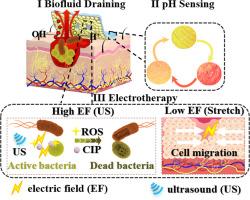Smart wound management with sustainable pH sensing and dynamic electrotherapy
IF 9.6
1区 医学
Q1 ENGINEERING, BIOMEDICAL
引用次数: 0
Abstract
Smart wound management remains a significant challenge, necessitating real-time monitoring and dynamic treatment. Herein, an innovative multifunctional Janus dressing is designed to enable sustainable pH sensing, and provide dynamic drug delivery and electrical therapy at infected wounds. Specifically, the hydrophilic side is a pH-sensing layer with phenol red grafted onto amino-modified poly (2-hydroxyethyl methacrylate) via Mannich reaction, while the hydrophobic side contains drug-loaded piezoelectric particles semi-embedded in a polydimethylsiloxane matrix for therapeutic delivery. The dressing exhibits high flexibility (156 % elongation), strong water absorption (123 %), rapid pH sensing (∼1.5 min), and controllable piezoelectricity. Upon application, wound exudates are autonomously pumped through micropores to the hydrophilic layer, signaling infection, triggering drug release and “high electric field” treatment via external ultrasound, achieving an antibacterial treatment with a rate of up to 97.5 %. Following antimicrobial treatment, natural body movements and skin tension exert mechanical loading on the dressing, facilitating self-powered “low electric field” stimulation for tissue repair. The smart wound management effectively detects wound infection and delivers dynamic, adaptive electrotherapy, reducing inflammatory responses, accelerating collagen deposition, and enhancing tissue regeneration. This study presents a promising approach for advancing integrated wound dressings that unify diagnosis and therapy.
Statement of significance
A multifunctional Janus dressing was developed to benefit sustainable pH sensing, and enable drug delivery alongside dynamic electrotherapy. Upon application, wound exudate was automatically drawn through micropores into the hydrophilic layer, triggering the release of an infection signal that initiates drug release. Subsequently, antibacterial treatment was administered via a high electric field facilitated by external ultrasound. Following antibacterial therapy, a self-powered low electric field promoted tissue regeneration. The dressing exhibited 156 % elongation, 123 % water absorption, and a rapid pH response (∼1.5 min). Both in vitro and in vivo studies demonstrated that this strategy significantly accelerated wound healing, establishing a smart system for personalized wound management.

智能伤口管理与可持续的pH传感和动态电疗。
智能伤口管理仍然是一个重大挑战,需要实时监测和动态治疗。在此,一种创新的多功能Janus敷料旨在实现可持续的pH感应,并在感染伤口提供动态药物输送和电疗。具体来说,亲水性侧是通过曼尼希反应将苯酚红接枝到氨基修饰的聚(2-羟乙基甲基丙烯酸酯)上的ph感应层,而疏水性侧包含半嵌入聚二甲基硅氧烷基质中的载药压电颗粒,用于治疗递送。该敷料具有高柔韧性(156%伸长率)、强吸水性(123%)、快速pH感应(~ 1.5 min)和可控制的压电性。应用后,伤口渗出液通过微孔自动泵送至亲水性层,发出感染信号,触发药物释放,并通过外部超声进行“高电场”治疗,抗菌治疗率高达97.5%。抗菌处理后,自然的身体运动和皮肤张力对敷料施加机械负荷,促进组织修复的自供电“低电场”刺激。智能伤口管理有效地检测伤口感染,并提供动态,适应性电疗,减少炎症反应,加速胶原沉积,增强组织再生。本研究提出了一种有希望的方法来推进统一诊断和治疗的综合伤口敷料。意义声明:一种多功能Janus敷料被开发出来,有利于可持续的pH值传感,并使药物递送与动态电疗同时进行。应用后,伤口渗出液自动通过微孔进入亲水性层,触发感染信号的释放,从而启动药物释放。随后,通过外部超声促进的高电场进行抗菌治疗。抗菌治疗后,自供电低电场促进组织再生。敷料具有156%的伸长率,123%的吸水率和快速的pH响应(约1.5分钟)。体外和体内研究都表明,这种策略显著加速了伤口愈合,建立了个性化伤口管理的智能系统。
本文章由计算机程序翻译,如有差异,请以英文原文为准。
求助全文
约1分钟内获得全文
求助全文
来源期刊

Acta Biomaterialia
工程技术-材料科学:生物材料
CiteScore
16.80
自引率
3.10%
发文量
776
审稿时长
30 days
期刊介绍:
Acta Biomaterialia is a monthly peer-reviewed scientific journal published by Elsevier. The journal was established in January 2005. The editor-in-chief is W.R. Wagner (University of Pittsburgh). The journal covers research in biomaterials science, including the interrelationship of biomaterial structure and function from macroscale to nanoscale. Topical coverage includes biomedical and biocompatible materials.
 求助内容:
求助内容: 应助结果提醒方式:
应助结果提醒方式:


